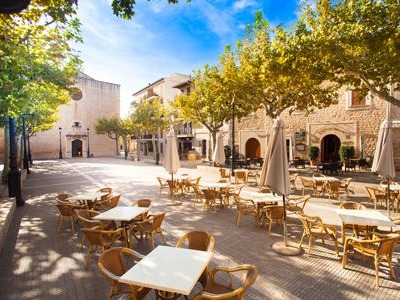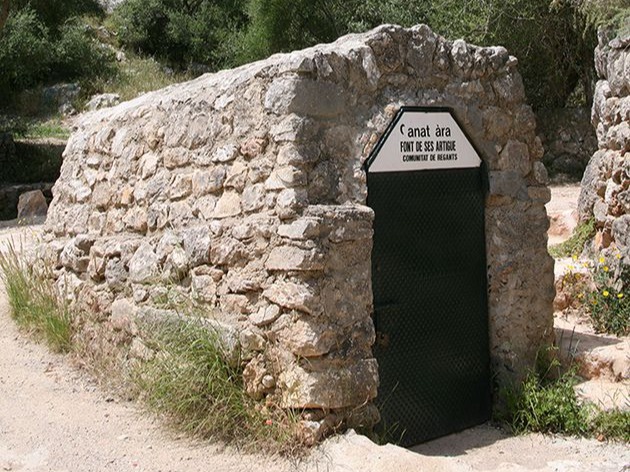Castle of Alaró
The climb to Castell d'Alaró is one of the most spectacular excursions in this beautiful mountainous area. This route is part of the group of dry stone paths rehabilitated and signposted by the Mallorca Council.
Characteristics
Difficulty easy-medium
Distance covered: 4.2 km
The castle is located at the top of Puig d'Alaró: the strength of the lookout lies in the natural location, the verticality of the mountain walls make it inaccessible and the only point by which you can go up is the path to the monument.
The castle path has asphalted sections on the first coasts while the last section retains cobbled pieces. You could also cover part of the journey by car, although, in any case, it must be completed on foot.
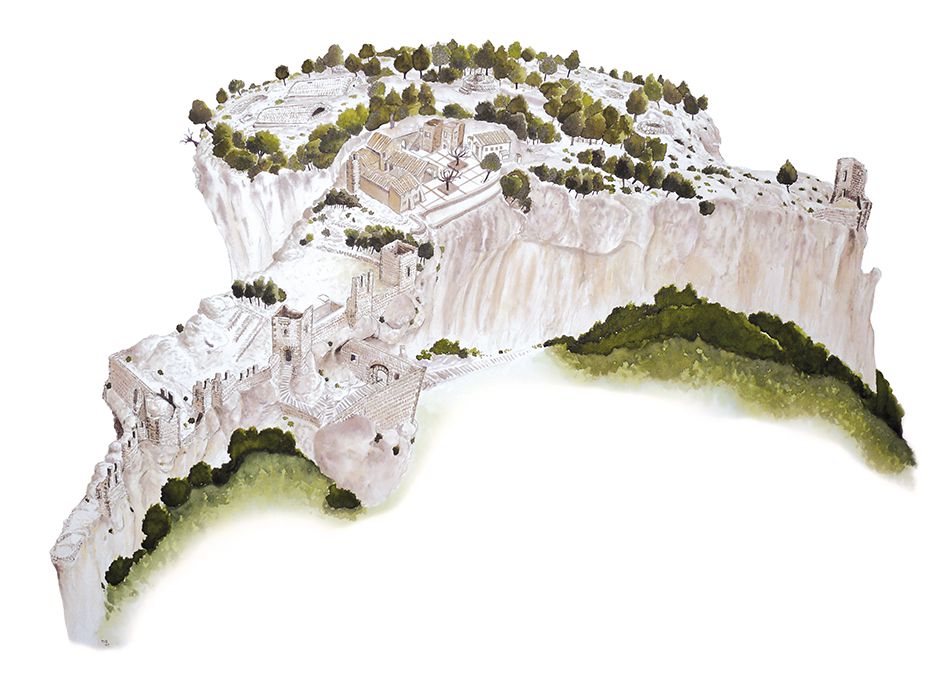
Drawing: Miquel Jaume
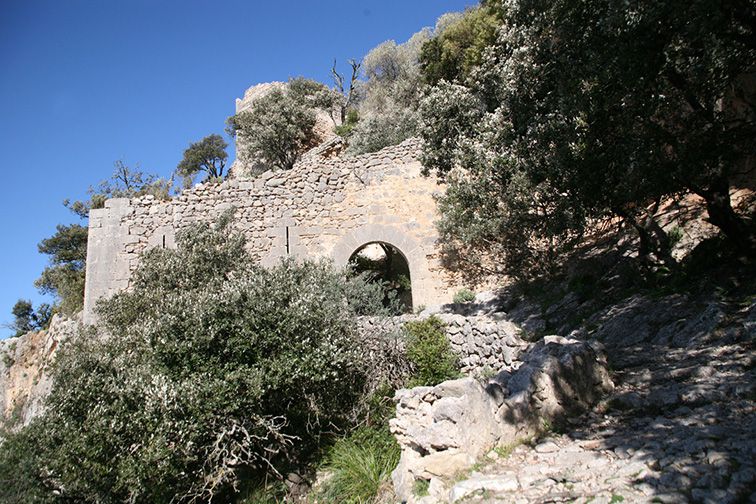
The excursion starts in the urban center of Alaró, you only have to follow the directions that lead to the Carretera d'Orient. This part of the trail is fully signposted and there is no getting lost. Already on the Orient road, the signs guide the walker and a post marks the deviation to the left going up towards the castle. This first asphalted route leads to the property of Son Curt, whose fence borders the road. A little further on, some second houses, those belonging to Son Penyaflor, currently converted into agrotourism.
From this point on, the original track is partly blurred. The primitive path shortens, by shortcuts, the concrete track, the most commonly used.
If the walker has not found the old path and has followed the modern track, a little further on, just after the dividing wall that divides the estates of Son Penyaflor and es Verger, an indicator has been placed that will lead him back from the cement track to the original track.
The shortcut continues to ascend between olive groves and pine groves, making turns that try to reduce the difficulty of the ascent by crossing the paved road several times until it leaves it for good a few hundred meters before reaching the Casas des Verger to go back directly through the forest to the base of the mountain cliffs. The path will lead us without the possibility of deviating to the portal of the first canvas of walls.
In this last stage of paved road, the traveler will be able to enjoy magnificent views of the town and its surroundings. On the steep red-colored wall (the blood spilled by the Muslims who defended the castle according to legend), on the visitor's back, climbs a large collection of endemics and native vegetation that will fascinate naturalists.
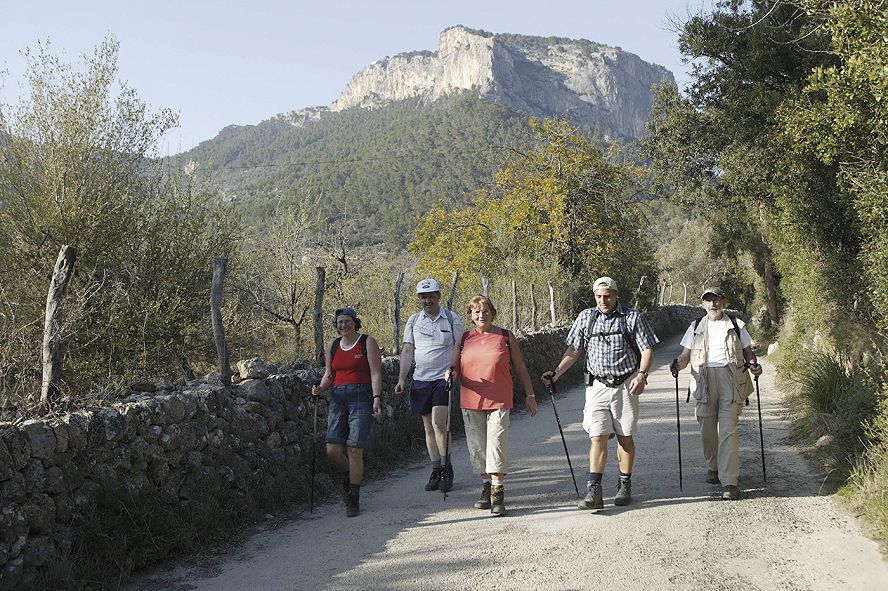
Arrival at the top
The military construction elements of the fort are composed of a first enclosure or rampart, adapted to the undulations of the rock, and an inner wall – the castle proper – composed of three closed watchtowers and a main one intended for the spanish.
The first enclosure is accessed through the outer portal, a portal with a semicircular arch, in which there is no trace of the double leaf doors that closed the passage. Crossing this first canvas, the steps lead us to a crenellated tower, known as the tribute tower or es Constipador, which must be crossed if you want to access the inside of the fortification. Es Constipador gets its name from the fact that after the expensive climb, visitors shelter and rest from the heat under the tower, where the pleasant and treacherous weather has caused more than one cold.
This watchtower has become the emblematic bulwark of the castle and – why not say it – of the Alaroners.
The current military structures are Gothic ruins of a 14th century castle. Due to its strategic importance, after the Conquest, the walls were planned and built, numerous maintenance works were carried out in the first decades and a permanent military detachment was located in the castle.
Stay at the Castle
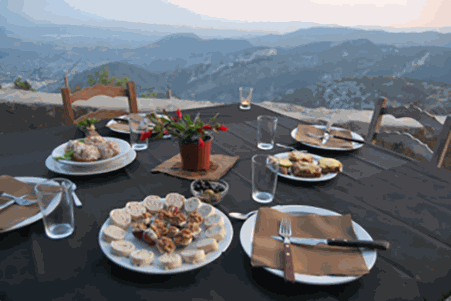
You can spend the night in the Alaró Castle facilities in a romantic way: spend a night within the walls of this old rock castle for the modest price of €12/15 per person. For this adventure you will only need a sleeping bag and a towel.
There has been a comprehensive reform that has provided the entire heating system, a cafe and a restaurant. In the restaurant you can order food and in the same bar you can also prepare something to eat. The inn can accommodate up to 30 people.
You shouldn't expect great luxuries or a very wide menu, water is limited and all supplies are carried on the backs of two donkeys, who, together with the host, are the only permanent inhabitants of the castle.
You must book in advance: 971 18 21 12. / www.castellalaro.cat
Among the construction elements that made up the rock castle, it can be assumed that there were no shortage of rooms for servants, kitchens, various flour mills, bread ovens and cisterns. A dungeon was also built in the bastion, with its usual instruments of torture.
The moments of greatest significance for Alaró Castle were the 13th, 14th and 15th centuries, which correspond to the dominance of the Royal House of Mallorca and its subsequent incorporation into the Crown of Aragon. The fortification was gradually abandoned, although a military garrison was maintained until 1741. Despite the efforts, most of the medieval towers have not withstood the passage of time and are half hollowed out without any work being carried out of recent rehabilitation or archaeological excavation.
Having crossed the wall and visited the watchtowers in the northern corner of the plateau, it remains to save a series of turns on the path that leads to the main group of buildings, consisting of the oratory and the inn. In this part of the climb, two dry stone walls close to the path act as viewpoints: they are the Orengar and the Lookout.
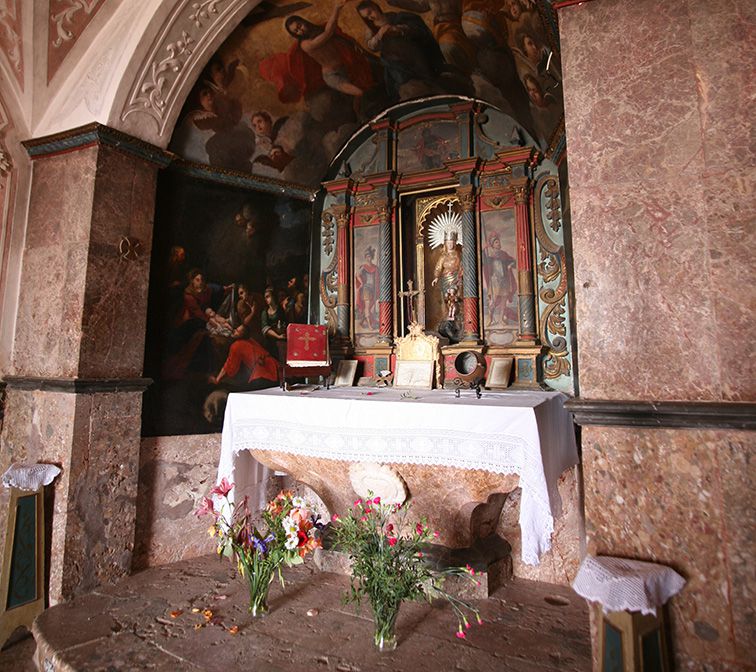
From the Orengar – the name it gets from the wild oregano that grows on the vertical walls – you get a beautiful panorama of the main mountains of the Serra de Tramuntana. The photo spans from the Serra d'Alfàbia to the Puig de Massanella, going through the Massif de l'Ofre, Tossals Verds and finally the roof of the island, the Puig Major.
In the second viewpoint you can see almost half of the island at a single glance: from the bay of Palma to the mountains of Felanitx; even, on clear days, you can see the silhouette of the Cabrera archipelago in the sea. At night thousands of lights twinkle at the foot of the castle.
The whole cliff has been included in the Natura 2000 network as a Site of Community Interest and a Special Protection Zone for Birds. Upon reaching the top, the visitor will encounter a wide esplanade where a whole series of facilities have been erected.
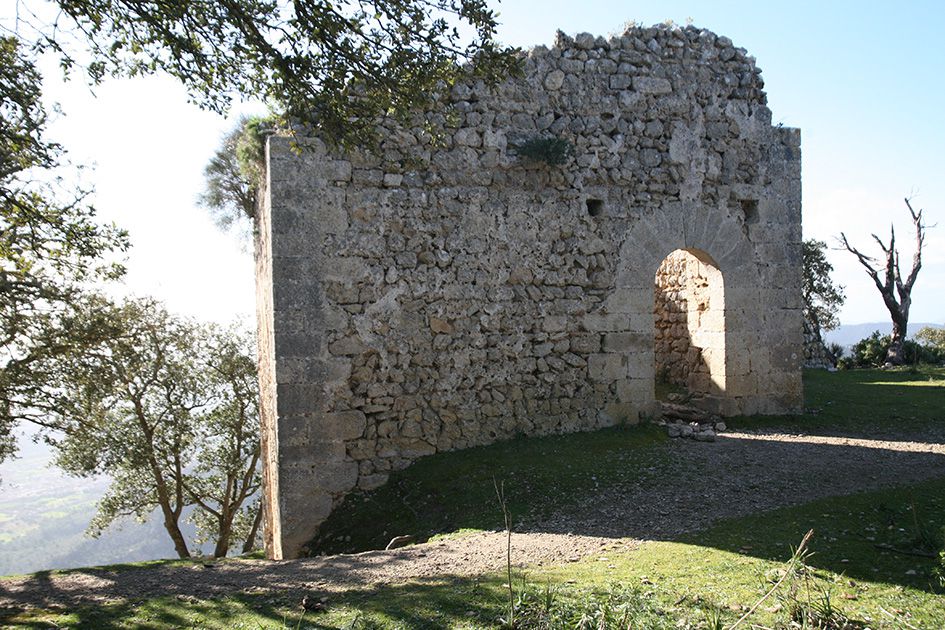
As was usual in medieval fortifications, the castle had a Gothic chapel, to be able to fulfill the spiritual obligations of the prominent staff. Over the years, the defensive activity of the fortification declined, while religious services and gatherings took on more and more prominence. With the building in 1622 of the oratory of Our Lady of Refuge, the castle of Alaró became definitively a sanctuary for the Alaroners.
The first stone of the oratory was placed on March 29, 1622, on the occasion of the great pilgrimage celebrated to implore rain after a long drought. When it ended, on November 6 of the same year, two ribs of Cabrit and Bassa were moved to the oratory from their grave in the chapel of Pietà under the organ of the Seu de Mallorca.
The building is of small dimensions and austere architecture. The main portal of carved marès draws an architraved composition in the Renaissance style. The portal is preceded by a double-sided Arabic tile portico, supported by a semicircular arch and octagonal pilasters on the sides. Inside the portico two wooden struts support the cover. The top vertex is crowned by a sundial.
The interior of the chapel consists of a single room, with a barrel arch, with a ceramic floor and walls decorated with plant motifs in relief by the Italian artist Antoni Soldati. The apse is semicircular and inside there is the altar preceded by a baroque altarpiece with the image of the Virgin Mary.
On the sides of the altarpiece, the two best-known figures in the history of Alaró, Guillem Cabrit and Guillem Bassa, who achieved the status of martyrs and saints for their brave defense of the castle of Alaró, have been represented. In the sacristy, the reliquary of Cabrit i Bassa and the large collection of votive offerings dedicated to the image of the Virgin Mary stand out. In 1622, the chapel and sacristy were added to the original building.
The religious use of the castle is also confirmed by the current viacrucis (1907) – a collection installed in the nineties of the 20th century, once the tiles of 1907 had disappeared –, which accompanies the visitor from the last section of the ascent to castle Of this viacrucis of stele with polychrome tiles that illustrate the different moments of the Passion, almost no remains remain on the road due to vandalism. The last scenes were placed on the walls of the buildings in Plaça de l'Oratori. The set of buildings around the Oratory Square have been renovated several times.
The conquest of Jaume I
A popular story describes the rise and taking of the castle by Jaume I:
After the conquest of the island of Mallorca, the castle of Alaró was still a Muslim fort when King Jaume I the Conqueror arrived at its gates. The attack on the fortification that Jaume I and his men made was on the way up, since there is no other point to do it.
Those on the lookout, constantly on the lookout, thought they could seize the monarch and descended to capture him.
It didn't happen, they didn't manage to make him go back even a step. The attackers soon became the attacked and had to turn back: in combat there was no man who could defeat King James and his horse.
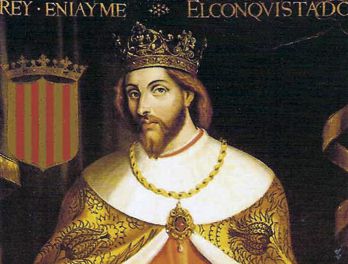
At the steepest point, where the stairs begin, the King's horse reared and advanced against the enemy with such force that hoof marks are still visible in the stone today.
The animal continued to climb, higher and higher, like a bird, and King James struck sword blows, one to the right, one to the left, and the heads of the rivals flew through the air and the bodies cut through fell to the ground. The blood of the Saracens covered everything, so much so that they have not yet been removed from the rocks and the grass that grows around.
The Conqueror continued to ascend and the Christians followed him, and the enemies who had not fallen, climbed the stairs of the castle to close in. But the King came so close that he prevented them from closing the door and entered with all his men.
The unfortunate besiegers of the rock castle could only escape the Christians if they threw themselves from the rocks.
To avoid getting hurt, they put their heads inside an alphabet, because they thought that, as a shepherd from the valley had told them, when they fell they wouldn't hurt themselves. You can imagine what was left of it, of those that were thrown away and of the alphabets: the biggest piece was nothing more than an ear.
Celebrations at the Castle
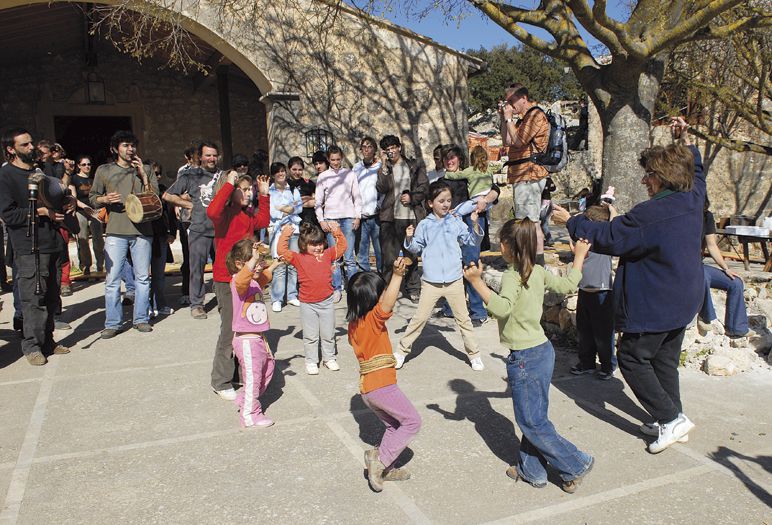
On the Sunday after Easter there is a climb to the castle to celebrate the Feast of the Angel or Pancaritat. The week after Easter in Mallorca has always been organized on foot to hermitages and sanctuaries to share the last panadas made for these holidays.
The first Sunday of September also celebrates the Nativity of the Virgin Mary with a popular lunch in front of the oratory.
The fort has not been properly populated, but it has had different inhabitants over the centuries: from military detachments to the hermit occupations of the mid-seventeenth century, and the most recent, the innkeeper, who opens the hermitage daily from 9 in the morning
A little away from the main group of buildings, there is a group of six Arab-type cisterns that supplied water and are in a good state of conservation. At a certain distance from the cisterns, the visitor can head towards the most remote tower, located to the south-east of the mill, with crenellated walls and arrowslits, which has been popularly called the Moorish Prison or Sa Cova Tower.
Very close to this last watchtower is the mouth of the cave of Sant Antoni, although you don't have to wait for a sign to announce it. This impressive irregular opening that opens into the cliff itself and is visible from the foot of the Alaró hill, offers a spectacular view from the interior of the lands at the foot of the elevation. This grotto was also used as a hermit in the 17th century.
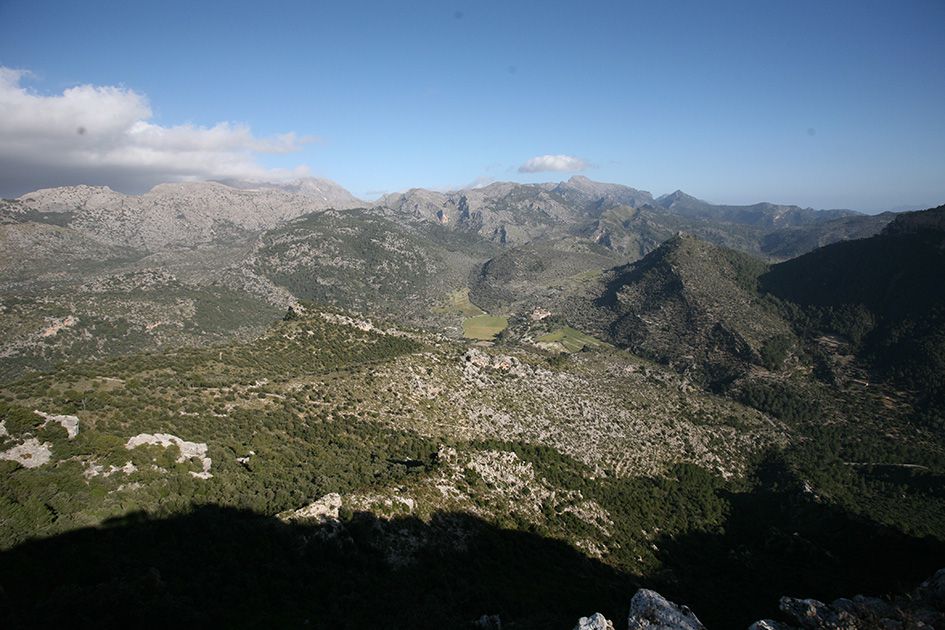
View of the Serra de Tramuntana from the Orengar viewpoint.
The set of buildings was declared an Asset of Cultural Interest in 1931.
The esplanade where the buildings are located is public property, divided equally between the City Council and the Bishopric, and is managed by the Castell d'Alaró Foundation . The Alaroners have fought for years to ensure that the castle remains in the hands of the municipality.
The incredible story begins in 1811, when the State puts the fort up for sale and, in an incredible financial effort on the part of the inhabitants of Alaró, the monument is bought with the doublours collected in harvest. The main symbol of the municipality was already owned by the Alaroners. But due to a new confiscation law, in 1885 the Central State again auctioned a property that was no longer its own. Excluded from the sale is the whole of the oratory, the inn and the walled enclosure that includes them, which remains in the hands of the Administration and which was one of the forgotten in 1983 with the transfer of powers to the Autonomous Community.
Returning to Alaró, the hiker can choose to return on the same path or take the detour, indicated by a wooden marker, towards El Pouet until reaching Les Cases des Verger, partly converted into a restaurant.
For those who want to do part of the climb by car, the easiest alternative is to leave it in the parking lot of the Verger restaurant and take the Camí del Pouet
